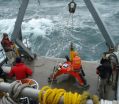Researchers applying modern scientific tools and mapping technologies, unavailable during Reisner's time, find his conclusions for the most part to be accurate and scientifically correct. As a result, current water practices are not sustainable and many dramatic initiatives will be needed to correct the current unsustainable path the West is on.
In a paper published in the Dec. 14, 2010, Online Early Edition of the Proceedings of the National Academy of Sciences, a research team led by John Sabo, an Arizona State University associate professor in the School of Life Sciences, confirms Reisner's assertions of the illusion of sustainability and ongoing water scarcity in the modern day American West.
"Reclaiming freshwater sustainability in the Cadillac Desert," is one of eight papers in a special section of PNAS. The special feature explores the challenges presented by the 21st century drought compared with earlier droughts in the Southwest, and analyzes the impact of greenhouse gases on the water supply.
"Cadillac Desert was prescient, published before a comprehensive analysis like this new study was possible," said Stephanie Hampton, deputy director of the National Center for Ecological Analysis & Synthesis at the University of California, Santa Barbara. "Using innovative approaches to scientific synthesis, Sabo and his colleagues provide a rich understanding of the status of Western water, and additional incentive to pursue the vision for sustainability that Cadillac Desert originally inspired in so many of us."
At the core of their analysis, Sabo and his colleagues applied the best available tools to data on water, soil, salt, dams, fish and crop yields. "Our data and analyses confirm with numbers and maps what Reisner deftly described with words," Sabo said.
Some of the primary findings are: Currently, the desert Southwest uses 76 percent of its total surface water to support its population. This will rise to 86 percent with a doubling of urban population (expected in 50 to 100 years). Sustainable balance for the region is achieved when 40 percent of total surface water is used. Salt, which results from the application of large quantities of water to grow drought intolerant food crops on desert farmlands, has likely caused about $2.5 billion in reductions in crop revenues in the Western U.S. The water footprints of Los Angeles, Las Vegas and Phoenix are the top three in the U.S. The footprint of Los Angeles alone is larger the seven largest eastern U.S. cities (including New York, Chicago and Washington, D.C.)
"California is arguably the most important farmland in North America," Sabo said. "But the water needed to support California agriculture (which is exported as food products to the rest of the country) is at odds with healthy populations of freshwater fish like salmon.
"Can we have salmon and tomatoes on the same table," he asks. "Something will have to give. We may have to embrace increases in the current rock bottom prices for water and high quality produce or policies that discourage rapid urban population growth and expansion unless we are willing to let go of the idea of healthy rivers, coastal waters and a viable salmon fishery in California."
Sabo and his team used advanced technologies to come to their conclusions. Geographical information systems, distributed hydrological models and innovative methods to quantify human water scarcity and water footprints were used by the team to dissect patterns of freshwater unsustainability in the western U.S.
"We found that many of the most rapidly growing cities and most important croplands in the U.S. are precisely in those western arid lands incapable of supporting them with regionally generated stream flow," Sabo said.
To reclaim sustainability in the Cadillac Desert, the team suggests several important and tough measures. One is aimed at lowering the huge amount of surface water required to sustain the region's population.
"We suggest an initially modest target of a 16 percent reduction (to 60 percent total) in the fraction of stream flow withdrawn," the researchers state. This alone would require the seven states that make up the region to do several things they have yet to do, including improving urban water use efficiency, implementing a desalinization system by coastal cities, improvements in land-use practices that minimize erosion and sediment infilling of the region's reservoirs and implementing modified crop portfolios that include only salt tolerant and cash crops.
"The water crisis in the West is a regional one," Sabo said. "This suggests that local conservation efforts (shorter showers, banning lawns, installing a gray-water recycling systems) are necessary but not sufficient for a solution. Regional and national policy changes are called for," he added.
"The cards are stacked high against freshwater sustainability in the West," Sabo added. "Something will have to give, and it likely will be the price of water and high quality produce. If water were priced appropriately (by market forces or policy mandates), we would become much more efficient with water use in cities and on farms, and we would likely do agriculture completely differently than we do it now in the Western U.S."
###
In addition to Sabo, the paper's authors are: Tushar Sinha, North Carolina State University; John Kominoski, University of Georgia; William Graf, University of South Carolina; Laura Bowling and Keith Cherkauer, Purdue University; Gerrit Schoups, Delft University of Technology; Wesley Wallender and Jan Hopmans, University of California, Davis; Michael Campana, Oregon State University; Pam Fuller and Robert Webb, U.S. Geological Survey; Carissa Taylor, Arizona State University; Stanley Trimble, University of California, Los Angeles; and Ellen Wohl, Warner College of Natural Resources, Colorado State University.
This research is supported by the National Science Foundation, the National Center for Ecological Analysis & Synthesis and Arizona State University.
Source: John Sabo, (480) 734-7120
Media contact: Skip Derra, (480) 965-4823; skip.derra@asu.edu
END


